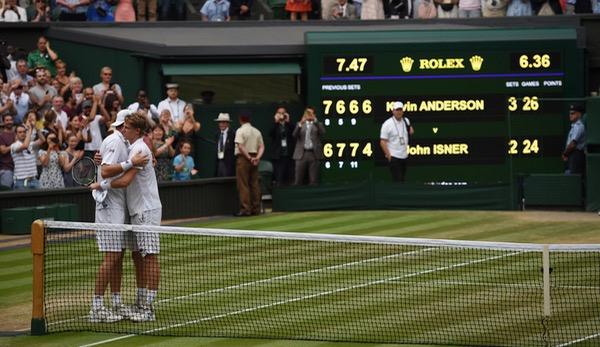Kevin Anderson and John Isner had an epic fight in Wimbledon on Friday. In the longest Grand Slam semi-final in history, the South African beat his US opponent 26:24 in the fifth set after more than six and a half hours of play. While both players loudly questioned the usefulness of the best-of-five format after the game, tennisnet editor Lukas Zahrer advocated the current game mode. A comment.
“I apologize for not being more enthusiastic now,” said Kevin Anderson after his greatest career success on grass. “But I really hope this match is a sign for the Grand Slams to rethink the format.”
Just minutes after defeating his long-time college colleague John Isner on Center Court, Anderson took the opportunity to express his displeasure at the game mode in Wimbledon in an interview with the BBC. He sees no additional benefit in artificially prolonging a match. Therefore, a tiebreak, as is usual in the matches at the US Open, is the more sensible option.
The defeated Isner, in turn the record holder for the longest tennis match in history since 2010 with Nicolas Mahut, also blew the same horn, but brought an alternative plan into play: “The most sensible option would be both at 12. If someone hasn’t killed their opponent by then, let’s play a tiebreak. It’s about time.”
But to shake the format after this epic match would be a mistake.
The Grand Slams are defined by their best-of-five. Even in the Davis Cup, the ITF now shortens the matches with a tie-break in the deciding set. To become Wimbledon Champion, however, you must win seven matches over the classic best-of-five format within 14 days. And that’s a good thing.
Isner has already mentioned the real dilemma: Just winning a match isn’t always enough. A major winner may waste little strength in the early rounds to be ready in the decisive phase of the tournament. In order to be able to compare the supposed fitness level of two players, the times that the opponents have spent on the court so far are often compared in late rounds. If you win a match but need too much power reserves, you don’t deserve a Grand Slam title.
In Wimbledon 2018, exactly five of the 125 matches so far went into an “extra time”. At the French Open, there were three games throughout the tournament in which a fifth set was played for two differences. Among them was the first round game of Marco Cecchinato, who even made it to the semi-finals.
Marathon games are therefore by no means the order of the day, but are still something special.
The reason for the uproar over the length of the match on Friday was that it was a real marathon in the semi-finals, and not, as in 2010, Isner vs. Mahut in the first round. Some so-called tennis fans demanded several times: “Get ready, we want to see Rafa.”
Last year, for example, when Nadal lost 13-15 to Gilles Muller from Luxembourg after almost five hours, neither player questioned the format. The international press reported exclusively positively about an exciting, epic match, because Nadal was there.
The drama of such games remains unparalleled; in no other sport has the format generated so many feelings and emotions over such a long period of time. In the match between Anderson and Isner, the ultimate decision could have been made at any moment in the two-hour and 55-minute decisive set. If you are looking for the next match in the fastest way, you are not a tennis fan.
By the ingenious counting method of the tennis, which makes it possible also for players, who make less points than the opponent, to win a match, for sufficiently drama is provided. Thus it comes every few minutes to a game win, a match is constantly littered with smaller highlights. At the end of the movement, the drama intensifies every 30 to 60 minutes.
The level of the second semi-final between Djokovic and Nadal was noticeably higher – that is undisputed. But to get to the drama of the role of Anderson and Isner, it takes two more movements.
Therefore, my request: never get rid of this best-of-five!














You must be logged in to post a comment Login